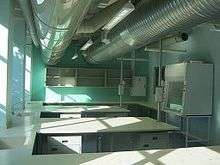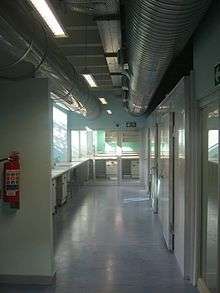University of the Witwatersrand School of Chemical and Metallurgical Engineering
 Richard Ward Building (right) | |
| Established | 1904 |
|---|---|
Academic staff | 25 |
| Undergraduates | approx. 800 |
| Postgraduates | approx. 100 |
| Location |
Johannesburg, Gauteng, South Africa 26°11′35.14″S 28°01′46.95″E / 26.1930944°S 28.0297083°ECoordinates: 26°11′35.14″S 28°01′46.95″E / 26.1930944°S 28.0297083°E |
| Website | Official Website |
The School of Chemical and Metallurgical Engineering is one of seven schools in the University of the Witwatersrand's Faculty of Engineering and the Built Environment.[1] The School offers 4-year undergraduate degrees and post-graduate degrees in chemical[2] and metallurgical engineering.
History
The University of the Witwatersrand was founded in 1904 as the SA School of Mines from the original 1896 Kimberley School of Mines. It moved to Johannesburg in 1904 after the second Anglo-Boer War (1899–1902) and became an autonomous university with its own charter and statute in 1922. While Metallurgical Engineering degrees were granted from the onset, Chemical Engineering degrees were granted from 1922 onwards. Chemical Engineering was originally part of the Department of Chemistry, and Chemical Engineering became a separate department in 1961. In 1995, the two departments of Chemical Engineering and Metallurgical Engineering merged, and after a brief period as the School of Process Engineering and Materials, became the School of Chemical and Metallurgical Engineering in 2005.[3]
The School will be celebrating its 21st birthday (as a combined entity) in 2015 and has several activities planned.
Location

The School is located in the Richard Ward Building on the East Campus of the University. The building is named after Richard Ward (1891–1976) who left R1 million to Wits on his death. At the time, this was the largest amount left to the University.[4]
In 2013, the School started major upgrades and modernisation of the building, with budgeted plans to the value of R75 million.[4] Renovations to date include:
– 2nd floor (Nanotechnology, Biotechnology, Coal, VOC and Syngas Laboratories)
– 7th floor (postgraduate office space)
Academic degrees
The School offers undergraduate and post-graduate degrees in chemical and metallurgical engineering.
Undergraduate degrees
- Bachelor of Science (Chemical Engineering)
- Bachelor of Science (Metallurgical Engineering)
Postgraduate degrees and graduate diplomas
- Graduate Diploma – Graduate Diploma in Engineering
- MSc – Master of Science
- PhD
Research
Research entities
The School has several research focuses:
NRF/DST Centre of Excellence in Strong Materials (CoE-SM)
Centre for strong materials.[5]
NRF/DST Chair in Sustainable Process Engineering
The work conducted under this chair can be broadly categorized into Batch and Continuous Process Integration. In Batch Process Integration research is focused on developing novel mathematical models for capturing the essence of time, which is the backbone of batch processes. These mathematical models are then used as the basis for energy and water optimization in multipurpose batch facilities. On the other hand, work on Continuous Process Integration is focused on Utilities Debottlenecking for energy and water optimization. The Chair's recent studies have also addressed systems that exhibit the water-energy nexus, as traditionally encountered in integrated water and membrane networks. [6]
Clean Coal Technology Research
The Clean Coal Technology Research group is the home of the DST/NRF funded SARChI Chair of Clean Coal Technology. Its expertise in coal processing, characterisation, and application, is amongst the best in the world. The group's interest lies in the in-depth research into coal and carbon as a material, and the advancement of technologies and industry practices that significantly increase coal conversion efficiency and decrease environmental impact.[7]

Industrial and Mining Water Research Unit (IMWaRU)
The Industrial and Mining Water Research Unit comprises several researchers in chemical engineering, microbiology and other disciplines, investigating acid mine drainage (AMD),[8] constructed wetlands, water footprinting, life-cycle assessment[9][10] and more.[11][12]
Minerals and Metals Extraction and Recovery Group (MMERG)
The group aims to develop new, improved and innovative processes for the beneficiation of various metals from a variety of different sources, including low grade ores, solid wastes and secondary sources of metals (e.g. electronic scrap). The group consists of Prof. Selo Ndlovu, Prof. Vusi Sibanda, Dr. Lizelle van Dyk, Dr. Geoffrey Simate and Prof. Herman Potgieter. A number of postgraduate students are being supervised on various projects ranging from bioleaching of metals to gas phase extraction of vanadium from spent catalysts.[13]
Tribology
Research into tribology.[14]
Bioprocessing engineering
Several research topics in the School focus on biochemical, bioprocess and related engineering fields.[15]
Research interests
The School also offers specialist research interests including: Attainable Region Theory,[16] Comminution (using Discrete Element Method-DEM) and flotation,[17] Engineering education,[18] Nanotechnology,[19] Petroleum engineering,[20] and Pyro-Metallurgy.[21]
Past heads of school
The following have been the Heads of the School:
- Prof. Herman Potgieter (2015 – current)
- Prof. Thoko Majozi (July – December 2014) – acting
- Prof. Sunny Iyuke (July 2009 – June 2014)
- Mr. Richard Bob Tait (May – June 2009) – acting
- Prof. Herman Potgieter (2004–2008)
- Prof. Hurman Rauf Eric (Jan – May 2004) – acting
- Prof. Walter Te Riele (2002–2003) (Process and Materials Engineering)
- Prof. Hurman Rauf Eric (1998–2001) (Process and Materials Engineering)
- Prof. David Glasser (Jan – Aug 1998) – acting (Process and Materials Engineering)
- Prof. A.W. Bryson (1995–1998) (Process and Materials Engineering)
References
- ↑ Wits University, Schools in the Faculty of Engineering and the Built Environment, retrieved 3 August 2014
- ↑ Educations.com, Bachelors in Chemical Engineering, retrieved 15 August 2014
- ↑ Eric, RH, 2006, A glimpse of pyrometallurgy at WITS, Southern African Pyrometallurgy, South African Institute of Mining and Metallurgy, Johannesburg, 5–8 March 2006.
- 1 2 Wits Foundation, Richard Ward Modernisation Project, retrieved 15 August 2014
- ↑ School of Chemical and Metallurgical Engineering, Research Units – CoE Strong Materials, retrieved 4 August 2014
- ↑ School of Chemical and Metallurgical Engineering, Research Units – Sustainable Process Engineering, retrieved 4 August 2014
- ↑ School of Chemical and Metallurgical Engineering, Research Units – Clean Coal, retrieved 22 September 2014
- ↑ Sheridan, C, 2013. Paying the Price, The Chemical Engineer, www.tcetoday.com, 30–32.
- ↑ Harding, KG, 2014. LCA Studies at the University of the Witwatersrand, UNEP/SETAC Presentation, Pretoria, South Africa.
- ↑ Harding, KG, 2013. A Technique for Reporting Life Cycle Impact Assessment (LCIA) Results, Ecol Ind, 34, 1–6.
- ↑ School of Chemical and Metallurgical Engineering, Research Units – IMWARU, retrieved 4 August 2014
- ↑ IMWaRU, 2014. Industrial and Mining Water Research Unit webpage
- ↑ School of Chemical and Metallurgical Engineering, Research Units – MERG, retrieved 4 August 2014
- ↑ School of Chemical and Metallurgical Engineering, Research Units – Tribology, retrieved 5 July 2015
- ↑ School of Chemical and Metallurgical Engineering, Research Units – Bioprocess Engineering, retrieved 5 July 2015
- ↑ "Doctor David Ming". Retrieved 25 June 2016.
- ↑ "Professor Emeritus Michael Moys". Retrieved 25 June 2016.
- ↑ "Associate Professor Lorenzo Woollacott". Retrieved 25 June 2016.
- ↑ "Doctor Geoffrey Simate". Retrieved 25 June 2016.
- ↑ "Professor Sunny Iyuke". Retrieved 25 June 2016.
- ↑ "Doctor Elias Matinde". Retrieved 25 June 2016.
